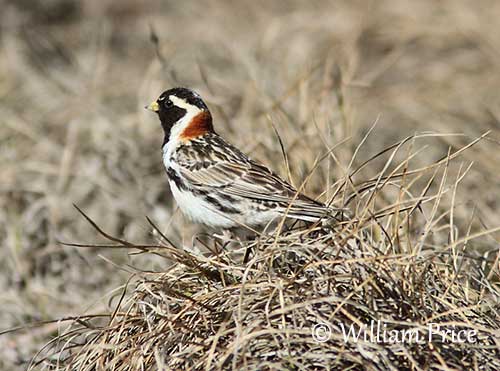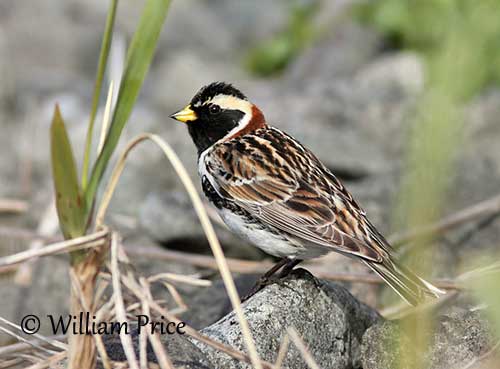
Fr: Bruant lapon – Plectrophane lapon
Ang: Lapland Longspur – Lapland Bunting
All: Spornammer
Esp: Escribano Lapón
Ita: Zigolo della Lapponia
Nd: IJsgors
Sd: Lappsparv
Photographers:
John Anderson
John Anderson Photo Galleries
Tom Grey
Tom Grey's Bird Pictures & Tom Grey's Bird Pictures 2
Tom Merigan
Tom Merigan’s Photo Galleries
Otto Plantema
Trips around the world
William Price
PBase-tereksandpiper & Flickr William Price
Simon Tan
PBase Bird galleries
Ingo Waschkies
My bird pictures on Pbase
Text by Nicole Bouglouan
Sources:
HANDBOOK OF THE BIRDS OF THE WORLD Vol 16 by Josep del Hoyo- Andrew Elliot-David Christie – Lynx Edicions – ISBN: 9788496553781
THE COMPLETE BOOK OF BRITISH BIRDS – Written by “Royal Society for the Protection of Birds” experts - Préface de Magnus Magnusson - Michael Cady- Rob Hume Editors - ISBN: 0749509112
THE HANDBOOK OF BIRD IDENTIFICATION FOR EUROPE AND THE WESTERN PALEARCTIC by Mark Beaman, Steve Madge - C. Helm - ISBN: 0713639601
FIELD GUIDE TO THE BIRDS OF NORTH AMERICA - National Geographic Society - ISBN: 0792274512
All About Birds (Cornell Lab of Ornithology)
Bird Web (Seattle Audubon Society)
What Bird-The ultimate Bird Guide (Mitchell Waite)
Wikipedia, the free encyclopaedia
Bird Species and Distributions in Yukon-Charley Rivers National Preserve
Lapland Longspur or Lapland Bunting
Calcarius lapponicus
Passeriformes Order – Calcariidae Family
INTRODUCTION:
The Lapland Longspur is a large, heavy bunting that breeds in tundra zone, in the northernmost parts of both Old and New Worlds. The name “longspur” refers to the elongated hind claw. It is now placed in the family Calcariidae, alongside the Snow Bunting and some other species.
The Lapland Longspur breeds in various treeless Arctic habitats, and nests on the ground. It winters S in open country such as pastures, fields and lake shores. It forages on the ground by walking, and often in flocks outside the nesting period.
This species is very common in suitable habitats, and has a wide range. It is not globally threatened.

DESCRIPTION OF THE BIRD:
Biometrics:
Length: 16-17 cm
Weight: 23-35 g
The Lapland Longspur male in breeding plumage has black face, crown, chin, throat and upper breast. The nape is rufous. There is a conspicuous whitish supercilium extending from above the eye (or faintly in front of the eye) to rear of ear-coverts. Then, it joins the white band that extends across head sides and down to breast sides.
The upperparts are heavily streaked brown, white, black and buff. The rump is paler and greyer. On the upperwing, the coverts are blackish with pale buffy edges. The flight feathers are dark brown with rufous to chestnut edges. The tail is dark brown with outermost rectrices edged and tipped white.
The underparts are buffy-white with black-streaked flanks.
The pointed bill is yellow to orange with reduced black tip. The eyes are dark brown. Legs and feet are blackish-brown with elongated hind claw.
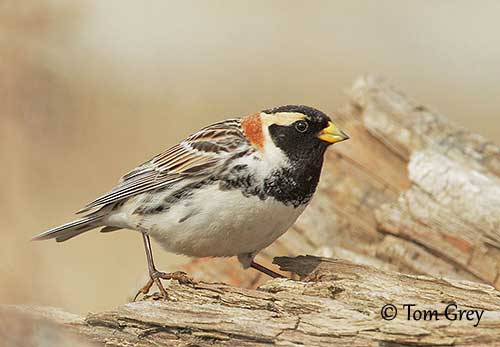
The non-breeding male has duller plumage with no black on head. But the crown is blackish-brown and the supercilium is buffy-white. The face is warm buff, outlined by black along the ear-coverts. The upperparts are streaked and browner than in breeding plumage. The upperwing is more rufous, especially the rufous panel on greater coverts.
On the underparts, the throat is whitish and the upperbreast appears variably blackish or with a breast band. Rest of underparts is white with brown streaks on flanks. The bill is dull brown instead of yellow.
The Lapland Longspur female in breeding plumage resembles non-breeding male, but she has paler head with blacker lateral crown stripe, eye stripe, moustachial and malar stripes, surrounded by whitish supercilium and band behind ear-coverts. The breast is less black, mostly streaked than uniformly black.
The non-breeding female is duller and paler than the non-breeding male. The nape is browner or greyer, and the black is lacking on breast. The bill is pinkish-brown.
The juvenile resembles non-breeding adult but it is duller, darker and more streaked overall.
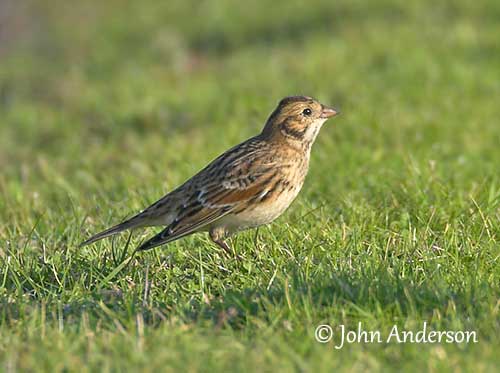
SUBSPECIES AND RANGE:
The Lapland Longspur has three subspecies, sometimes five according to the authors.
C.l. alascensis breeds on Pribilof Islands, N and W Alaska and NW Canada. It winters in extreme S Canada and USA, to NE California, N Arizona and N Texas.
This race is paler than nominate, with narrower streaking above, less black on flanks, more ochre supercilium and larger bill.
C.l. lapponicus (described above) breeds in N Canada and W and S Greenland, and from W and N Fennoscandia E across Siberia to Bering Strait. It winters in USA, Colorado, Wisconsin, N Texas, Tennessee and Delaware, and SE Canada. In Palearctic, it winters on S North Sea shores, CE Europe and E across Asia to Russian Altai, Mongolia and N China.
C.l. coloratus breeds in E Siberia, on Kamchatka Peninsula and Commander Islands. It winters in E China, and occasionally Sakhalin Island, Korea and Japan.
This race is larger than others, with much darker upperparts and rusty-edged greater coverts and tertials.
Two more subspecies are sometimes recognized but not described:
C.l. subcalcaratus is found in N Canada and Greenland.
C.l. kamtschaticus occurs in NE Siberia.
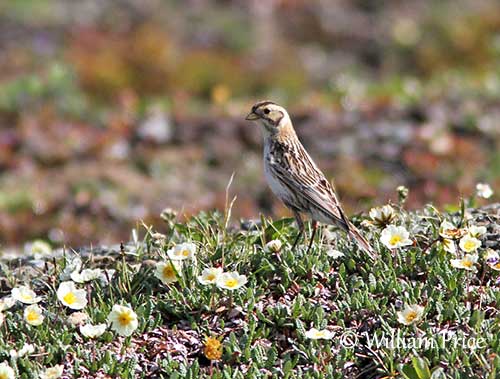
HABITAT:
The Lapland Longspur breeds in tundra, usually among sedges and grasses, heather and small trees, at the edge of the tree line. It also frequents open wet tundra and sedge meadows to drier upland tundra. It avoids forests or thickets, and does not frequent rocky areas like the Snow Bunting.
It winters in open country such as meadows and pastures with short grass, stubble fields and lake shores. It occurs from sea-level to 500 metres of elevation, but higher too, up to 1300/1500 metres.
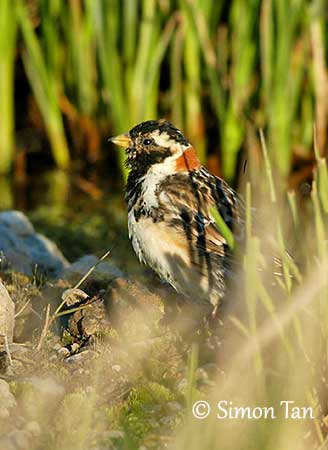
CALLS AND SONGS: SOUNDS BY XENO-CANTO
The Lapland Longspur’s usual call is a dry, musical twitter “ticker-tik-tik”, or “ticky-tik” or “prrrt” often given in flight. This call is often preceded or followed by a short, clear “teu”. During the breeding season, it gives a repeated piping “dyuee” followed by “treeu” after a pause.
The song is a short, warbled phrase similar to that of the Horned Lark. This song is given from a perch, often a rock, but also during a short song flight when the male descends on outstretched wings.
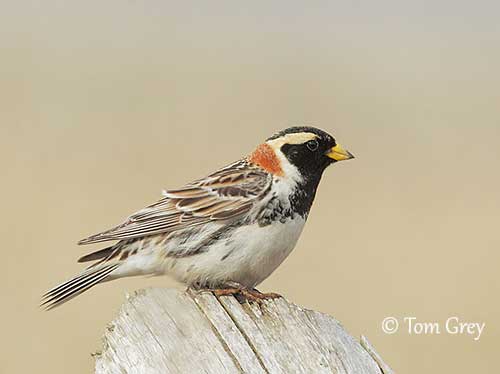
BEHAVIOUR IN THE WILD:
The Lapland Longspur feeds mainly on seeds and insects. The winter diet includes primarily seeds of grasses, weeds and sedges, and it also takes waste grain.
During summer, seeds are about the half of the diet, but it feeds primarily on various insects such as flies, beetles, true bugs, caterpillars and spiders.
The Lapland Longspur feeds mainly by walking on the ground while searching for seeds and invertebrates. It crouches low and can run quickly and rather jerkily. Outside the breeding season, it often forages in flocks, and sometimes with the Horned Lark in winter.
At the beginning of the breeding season, the male arrives some days before the female at the breeding grounds. It starts to sing and display, in order to establish the territory. The male flies up from the ground, up to 90-100 metres into the air or higher, before to glide down while singing. During the displays on the ground, the male runs about with drooped wings and bill pointed up, always while singing.
As the Arctic summer is short, courtship and pair formation are very rapid, and the female starts to build the nest almost as soon as she arrives. They are monogamous.
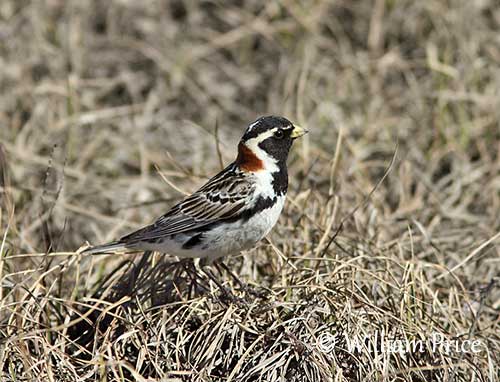
The Lapland Longspur is migratory, and travels both by day and at night. They leave the wintering areas in late February/early March in N America, and arrive in late May/early June at their breeding grounds. But departures and arrivals may vary according to the range. Arrivals to northernmost breeding range occur mostly between mid-May and mid-June. The Lapland Longspur migrates alone or in small flocks, and joins other species at stopovers.
The Palearctic birds performs the spring migration from mid-March to May/early June, and the autumn migration occurs between late September and late December.
It may move farther South in bad weathers conditions, including strong snow falls.
The Lapland Longspur has pointed wings and migrates over long distances. The flight is powerful with several rapid wingbeats interspersed with glides on wings pulled to body sides.
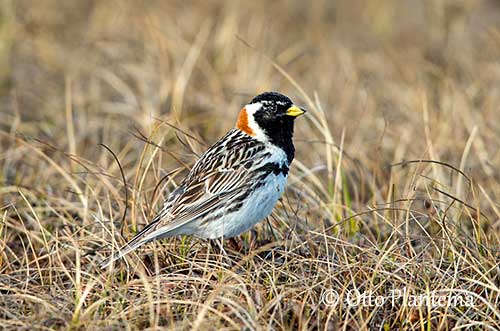
REPRODUCTION OF THIS SPECIES:
The breeding season varies according to the range, but the Lapland Longspur breeds during summer and usually produces a single brood.
The female builds the nest on the ground, a cup-shaped structure placed in shallow depression in moss or other vegetation in tundra. The nest is made with grass and moss, and the cup is lined with finer grass and feathers.
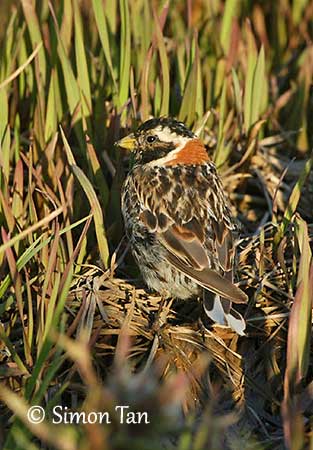
She lays 4-6 whitish to pale grey-green eggs with dark markings. She incubates alone during 12-13 days. She is sometimes fed by its mate during this period. The chicks are fed by both parents, and leave the nest about 8-10 days after hatching. They still depend on adults during several days. They are not able to fly when they leave the nest, but they run in the grass. They can fly at 13-15 days old. Parents equally divide the brood and rear the young separately.
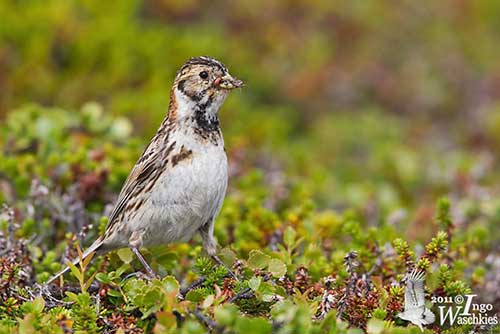
PROTECTION / THREATS / STATUS:
The Lapland Longspur is abundant and widespread throughout the range. The nesting areas are established in remote regions, far from the impact of human activities. The natural predation by the Arctic Fox does not reduce the population. However, bad weather conditions such as snowstorms may kill several thousands of birds.
The global population was estimated to number 150,000,000 individuals in 2004. It is slightly increasing in North America.
The Lapland Longspur is currently evaluated as Least Concern.
